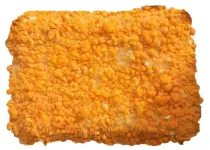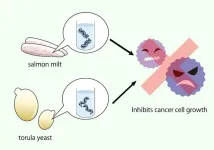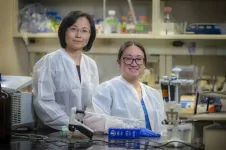One of his collaborators is Rasmus Munk, head chef and co-owner of the Michelin two-star restaurant Alchemist in Copenhagen, who serves a dessert — orange-colored Neurospora mold grown on rice — inspired by Hill-Maini.
For the past two years, Hill-Maini has worked with a team of chefs at Blue Hill at Stone Barns, a Michelin two-star restaurant in Pocantico Hills, New York, to generate tasty morsels from Neurospora mold grown on grains and pulses, including the pulp left over from making oat milk. At Blue Hill, you may soon be served a patty of grain covered with orange Neurospora with a side of moldy bread — orange Neurospora grown on rice bread that, when fried, smells and tastes like a toasted cheese sandwich.
That's only the beginning for Hill-Maini, a Miller postdoctoral fellow at the University of California, Berkeley. Working in the lab of Jay Keasling, UC Berkeley professor of chemical and biomolecular engineering, he has devoted himself to learning everything there is to know about Neurospora intermedia — a widespread fungus that is traditionally used in Indonesia to make a food called oncom (pronounced ahn' cham) from soy pulp — so it can be adapted broadly to Western food waste and Western palates.
"Our food system is very inefficient. A third or so of all food that's produced in the U.S. alone is wasted, and it isn't just eggshells in your trash. It's on an industrial scale,” said Hill-Maini. “What happens to all the grain that was involved in the brewing process, all the oats that didn't make it into the oat milk, the soybeans that didn't make it into the soy milk? It's thrown out."
When a fellow chef from Indonesia introduced him to fermented oncom, he said it struck him that "this food is a beautiful example of how we can take waste, ferment it and make human food from it. So let's learn from this example, study this process in detail, and maybe there's broader lessons we can draw about how to tackle the general challenge of food waste."
Hill-Maini's evangelizing about the benefits of Neurospora inspired Blue Hill to install an incubator and tissue culture hood in its test kitchen this summer, allowing the restaurant to dive more deeply into fungal foods. Before, Luzmore, chef in charge of special projects, FedExed various substrates to Hill-Maini's lab at the Joint BioEnergy Institute (JBEI) in Emeryville, California, near UC Berkeley, where Neurospora magically transformed them for study. Luzmore has tasted many Neurospora experiments, though his favorite is made from stale rice bread.
"It’s incredibly delicious. It looks and tastes like you grated cheddar onto bread and toasted it," Luzmore said. "It's a very clear window into what can be done with this."
While people from many cultures have long eaten foods transformed by fungi — grain turned into alcohol by yeast, milk curds turned into blue cheese by Penicillium mold, soy sauce and miso produced from soybeans by koji mold (Aspergillus oryzae) — oncom is unique in being produced from waste food. Developed by native Javans long ago, it appears to be the only human food fermented solely by Neurospora mold. But not for long.
A paper by Hill-Maini about the genetics of the Neurospora intermedia strains that transform soy milk waste into oncom, and how the fungi chemically alter 30 different kinds of plant waste, will be published online Aug. 29 in the journal Nature Microbiology.
"In the last few years, I think, fungi and molds have caught the public eye for their health and environmental benefits, but a lot less is known about the molecular processes that these fungi carry out to transform ingredients into food," he said. "Our discovery, I think, opens our eyes to these possibilities and unlocks further the potential of these fungi for planetary health and planetary sustainability."
A nutritious snack in 36 hours
In West Java, oncom comes in two varieties: red oncom, which is made by fermenting soy pulp left over from making tofu, and black oncom, which is grown on the leftover pressings from making peanut oil. They're used similarly — in stir-fries, as fried snacks and with rice as a dumpling filling.
One of the amazing things about these moldy concoctions, Hill-Maini found, is that the fungi transform indigestible plant material — polysaccharides, including pectin and cellulose, originating from the plant cell wall — into digestible, nutritious and tasty food in about 36 hours.
"The fungus readily eats those things and in doing so makes this food and also more of itself, which increases the protein content," he said. "So you actually have a transformation in the nutritional value. You see a change in the flavor profile. Some of the off-flavors that are associated with soybeans disappear. And finally, some beneficial metabolites are produced in high amounts."
Yeast — a single-celled fungus — is famously transformative, fermenting grain and fruit into alcohol. But the fungus that makes oncom is different: it's a filamentous fungus, growing and spreading as filaments identical to the mycorrhizae of fungi that live in forest soil and produce mushrooms. The oncom fungus does not produce mushrooms, however; it is like the mold that grows on spoiled food. The Penicillium mold that produces blue cheese and the koji mold that produces soy sauce, miso and sake are examples of filamentous fungi that raise bland food to a whole new level.
Oncom, however, is one of the only, if not the only, fungal food grown on food by-products. In the new paper, Hill-Maini demonstrated that N. intermedia can grow on 30 different types of agricultural waste, from sugar cane bagasse and tomato pomace to almond hulls and banana peels, without producing any toxins that can accumulate in some mushrooms and molds.
He also analyzed the genetics of the fungi that produce oncom. Surprisingly, he found that the fungus responsible for red oncom is primarily N. intermedia — it was the main fungus in all 10 samples from West Java.
"What was very clear is, wow, this fungus is probably dominant and maybe sufficient for making this food possible, growing on the cellulose-rich soy milk waste and making the food in 36 hours," Hill-Maini said.
The fungi in black oncom, however, were dominated by a range of Rhizopus species that depended on where it was made. It also contained many bacteria. Tempeh, another ancient and popular Javanese source of protein, is also produced by Rhizopus mold fermenting fresh soybeans.
Delving deeper into the genetics of the Neurospora in red oncom and comparing its genes with the genes of Neurospora intermedia strains not found in red oncom, he discovered that there are essentially two types of the mold: wild strains found worldwide, and strains adapted specifically to agricultural waste produced by humans.
"What we think has happened is that there's been a domestication as humans started generating waste or by-products, and it created a new niche for Neurospora intermedia. And through that, probably the practice of making oncom emerged," Hill-Maini said. "And we found that those strains are better at degrading cellulose. So it seems to have a unique trajectory on waste, from trash to treasure."
But is it tasty?
Since the domesticated Neurospora strain degrades the cellulose in soy and peanut waste into a tasty food, Hill-Maini wondered if it could make other waste products edible.
"The most important thing, especially for me as a chef, is, 'Is it tasty?' Sure, we can grow it on all these different things, but if it doesn't have sensory appeal, if people don't perceive it positively outside of a very specific cultural context, then it might be a dead end," he said.
In collaboration with Munk at Alchemist, he presented red oncom to 60 people who had never encountered it before and asked their opinions.
"We found that, basically people who never tried this food before assigned it positive attributes — it was more earthy, nutty, mushroomy," Hill-Maini said. "It consistently rated above six out of nine."
The chefs at Alchemist also grew Neurospora on peanuts, cashews and pine nuts and everyone liked those, too, he said.
"Its flavor is not polarizing and intense like blue cheese. It's a milder, savory kind of umami earthiness," Hill-Maini said. Different substrates impart their own flavors, however, including fruity notes when grown on rice hulls or apple pomace.
This led Munk to add a Neurospora dessert to Alchemist's menu: a bed of jellied plum wine topped with unsweetened rice custard inoculated with Neurospora, left to ferment for 60 hours and served cold, topped with a drop of lime syrup made from roasted leftover lime peel.
“We experienced that the process changed the aromas and flavors in quite a dramatic way — adding sweet, fruity aromas," Munk said. "I found it mind-blowing to suddenly discover flavors like banana and pickled fruit without adding anything besides the fungi itself. Initially, we were thinking of creating a savory dish, but the results made us decide to instead serve it as a dessert."
This dessert was among other edible Neurospora fermentations discussed in a paper published last December in the International Journal of Gastronomy and Food Science, in which Hill-Maini, Munk and their colleagues reported on taste tests of oncom and oncom-like foods grown on substrates other than soy.
“I think it is amazing that we as a restaurant can contribute something like this to the scientific community," Munk added. "We have said from the start that Alchemist’s ambition is to change the world through gastronomy, and this project has that kind of potential. I am very excited to see what other culinary applications this research can lead to in the future and using other waste products from the food industry."
Munk recently launched a food innovation center, Spora, initially focused on upcycling side-streams from the food industry and developing delicious and diverse protein sources.
A culinary upbringing
Hill-Maini grew up in a household centered around cooking. His mother, of Indian descent from Kenya, held cooking classes in their apartment in Stockholm, Sweden, in the 1990s, introducing Swedes to the spices and cooking styles of India. His father is of Cuban and Norwegian descent.
"Growing up, I got connected to cooking really early on as a way to understand my cultural heritage and where I came from," he said.
After high school, he took his love of cooking to New York City, where he worked low-level food-prep jobs at several restaurants before impressing one employer with the sandwiches he brought for lunch. At the age of 18, he was chosen to redesign the menu of a venerable sandwich shop in Manhattan. One creation was voted among the city's top veggie sandwiches by the New York Times.
He eventually returned to school, supporting himself as a chef for hire, and became interested in the science behind the chemical transformations possible with cooking. After obtaining his bachelor's degree from Carleton College in Northfield, Minnesota, he was accepted into the graduate program at Harvard University, where he studied biochemistry and did Ph.D. work on the gut microbiome.
"Then, you know, I wanted to come back to the kitchen," he said. "The Miller Fellowship was an opportunity to say, ‘I have training in the culinary world. I have training in biochemistry, microbiology. How do I bring them together, especially looking at the sustainability challenges that we're facing and how wasteful and devastating our food system is on the planet?’"
With fellowship support, he visited restaurants — including Blue Hill, Alchemist and the Basque Culinary Center in Spain — to give workshops on fermentation.
"That inspired me to go back to Berkeley and think about my research differently," Hill-Maini said.
Blue Hill has hosted him five times over the past two years, most recently in late June to help inaugurate the restaurant's microbiology lab, where Luzmore hopes Hill-Maini and other chef-scientists will visit and experiment.
"The reason why we have loved working with Vayu so much is because I think he really embodies a lot of where we are going," Luzmore said. Now 20 years old, the for-profit Blue Hill restaurant and the nonprofit Stone Hill Farm are transitioning from being a champion of farm-to-table dining to "endeavoring to make research a bigger part of what we do here and not just have it be a farm and a restaurant, but really, hopefully, be a hub of innovation — what I feel to be a sandbox — and to bring people in, like Vayu, to do this research."
In addition to playing in Blue Hill's sandbox, Hill-Maini will soon have his own: a kitchen-equipped lab at Stanford University, where he has been appointed an assistant professor of bioengineering.
Taste test
Sauteing an oat milk waste burger he made in his Berkeley apartment last June, Hill-Maini talked enthusiastically about the opportunities opened up by Neurospora and the debt he owes to the Javanese, who long ago coopted the fungus to make oncom. Neurospora provides another type of fermentation complementary to the widely used koji mold, which in recent years has been adapted by chefs to transform so many foods that it has become tiresome, he said.
"This is a new tool in the chef's toolbox," he said.
Hill-Maini plated the perfectly-seared burger, indistinguishable from a small beef patty, on a bed of cashew-avocado sauce, pairing it with roasted sweet potatoes and a fresh cucumber-cherry tomato salad with herbs and lemon. He cut the burger with a fork, swirled it through the sauce and lifted it to his mouth.
"Mmm, look at that — waste to food," he said. "It has good bite, it's savory, a note of mushrooms, some fun, fruity aromas."
In future research, he hopes to discover how Neurospora produces these flavors and aromas, but at the same time make a dent in the food waste stream.
"The science that I do — it's a new way of cooking, a new way of looking at food that hopefully makes it into solutions that could be relevant for the world," he said.
------------
Hill-Maini's co-authors on the Nature Microbiology paper include Keasling; Munk, Nabila Rodriguez-Valeron, Mikel Olaizola Garcia and Diego Prado Vásquez of Alchemist; José Manuel Villalobos-Escobedo of UC Berkeley; Alexander Rosales and Edward Baidoo of JBEI, part of Lawrence Berkeley National Laboratory; Christofora Hanny Wijaya, Lilis Nuraida and Isty Damayanti of Bogor Agricultural University in Dramaga, Indonesia; and Ana Calheiros de Carvalho and Pablo-Cruz Morales of the Technical University of Denmark in Lyngby. The genome sequencing was performed at Berkeley Lab's Joint Genome Institute by Robert Riley, Anna Lipzen, Guifen He, Mi Yan, Sajeet Haridas, Christopher Daum, Yuko Yoshinaga, Vivian Ng and Igor V. Grigoriev.
END





